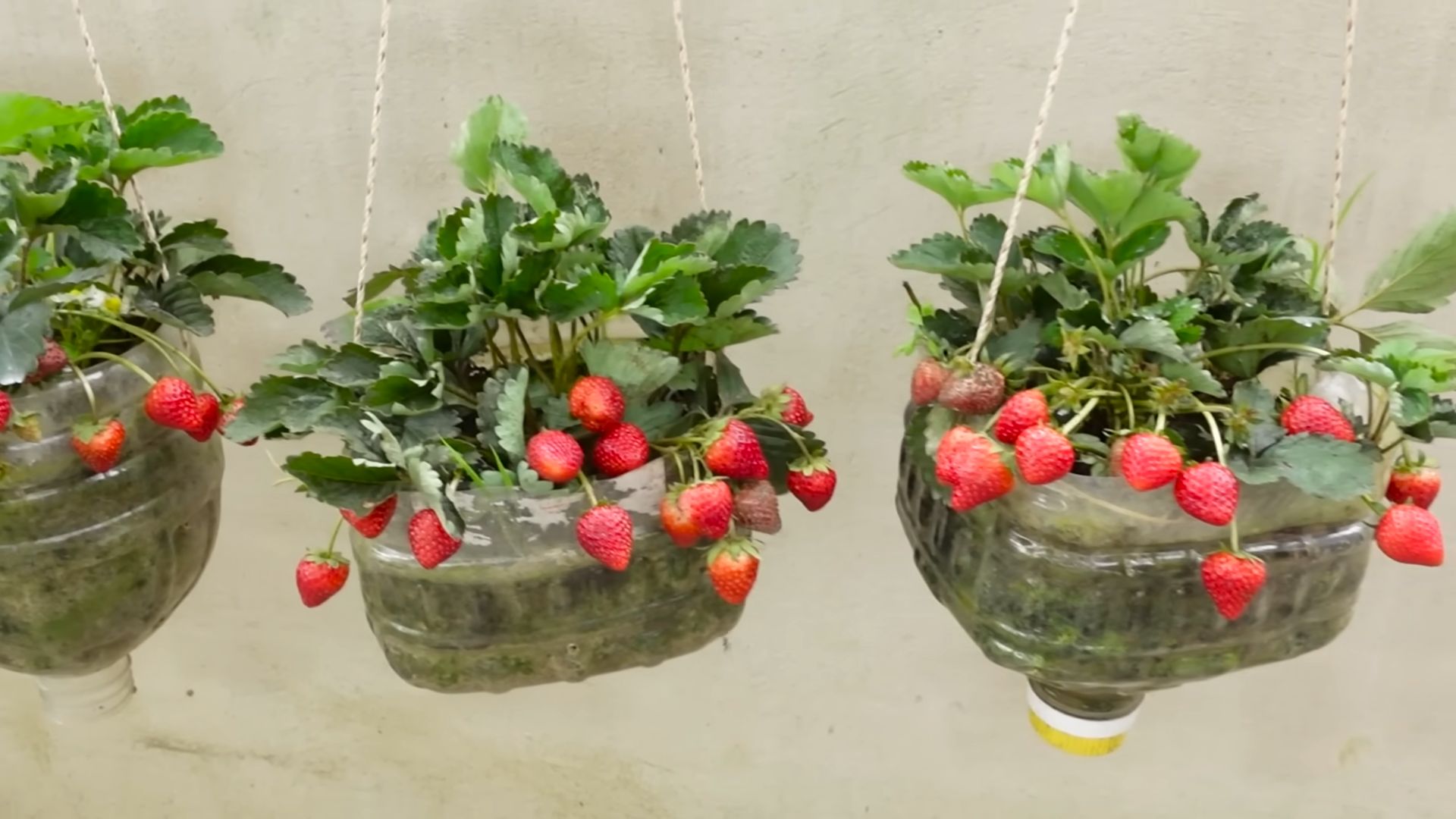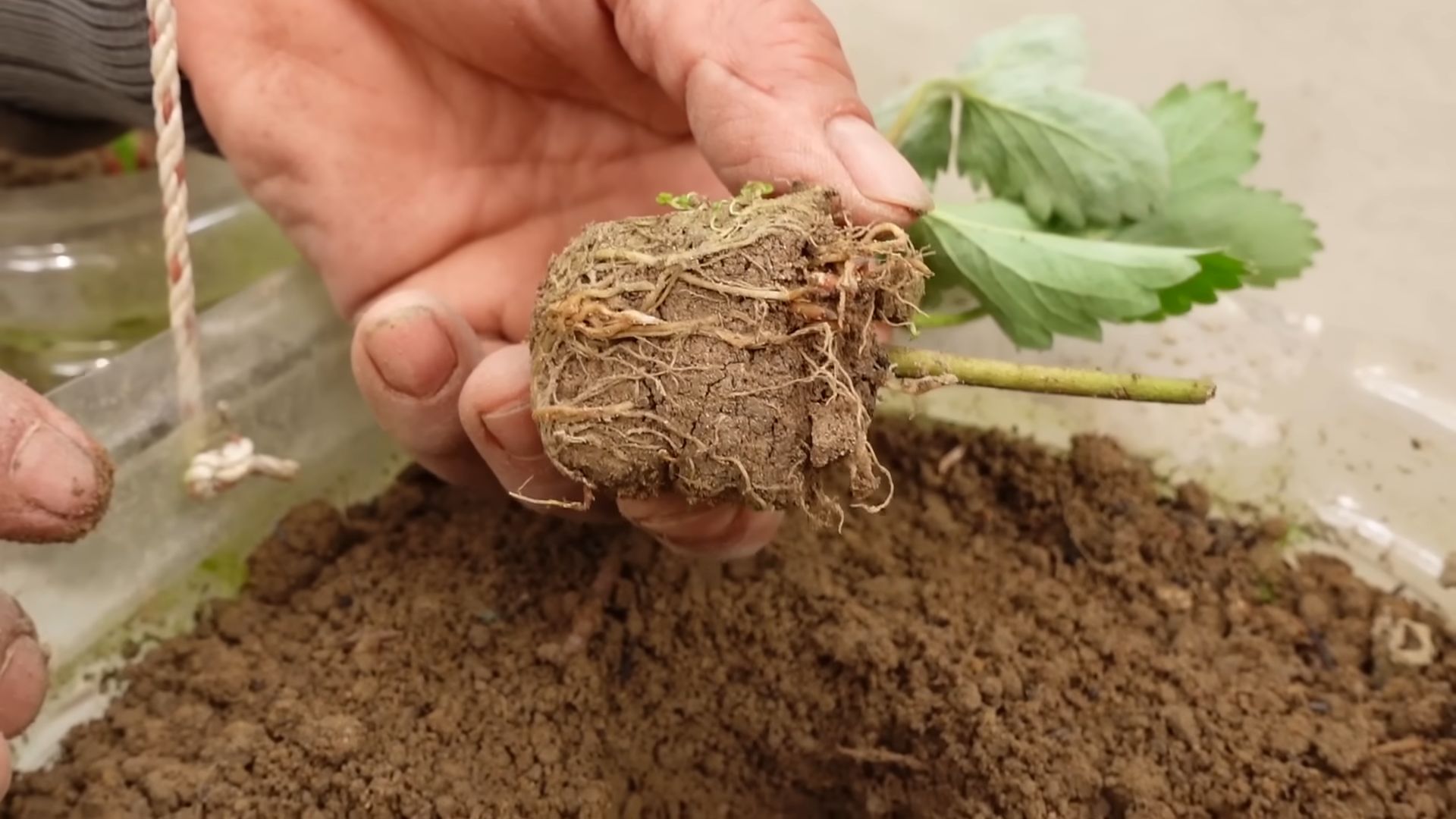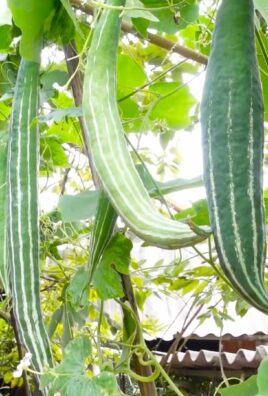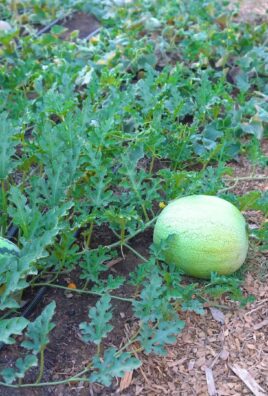Strawberry harvest without a garden? Absolutely! Imagine biting into a juicy, sun-ripened strawberry you grew yourself, even if you don’t have a sprawling backyard. It sounds like a dream, right? Well, get ready to turn that dream into a delicious reality with these amazing home gardening tricks and DIY solutions!
For centuries, cultivating strawberries has been a cherished tradition, representing the sweetness of summer and the bounty of nature. From ancient Roman gardens to medieval monastery plots, strawberries have held a special place in our hearts and diets. But what if you live in an apartment, have limited space, or simply lack the time for traditional gardening? That’s where these clever DIY hacks come in.
Let’s face it, fresh, organic strawberries from the store can be expensive, and sometimes they just don’t have that incredible flavor you crave. Plus, there’s something incredibly satisfying about nurturing your own food. That’s why I’m so excited to share these simple, yet effective, methods for achieving a bountiful strawberry harvest without a garden. We’ll explore everything from vertical planters and hanging baskets to container gardening secrets that will have you picking sweet, red berries in no time. So, ditch the store-bought berries and get ready to experience the joy of homegrown goodness! This article will guide you through the process of achieving a successful strawberry harvest without a garden, making fresh, delicious strawberries accessible to everyone.

“`html
Growing Strawberries Without a Garden: A DIY Guide to Container Gardening
Hey there, fellow strawberry lovers! Dreaming of juicy, red strawberries but lacking a traditional garden? Don’t worry, I’ve got you covered! You absolutely *can* grow delicious strawberries even if you only have a balcony, patio, or even a sunny windowsill. This guide will walk you through everything you need to know to create your own thriving strawberry container garden.
Choosing the Right Container and Location
First things first, let’s talk about where your strawberries will call home.
* Container Size: Strawberries need room to spread their roots. I recommend a container that’s at least 12 inches in diameter and 8 inches deep. Hanging baskets, window boxes, and even repurposed buckets work great! Just make sure they have drainage holes.
* Material: Plastic, terracotta, or even fabric pots are all suitable. Terracotta pots dry out faster, so you’ll need to water more frequently. Fabric pots offer excellent drainage and aeration.
* Location, Location, Location: Strawberries are sun worshippers! They need at least 6-8 hours of direct sunlight per day to produce a good harvest. A south-facing balcony or patio is ideal. If you’re growing indoors, a sunny windowsill or grow lights are essential.
Selecting Your Strawberry Plants
Now for the fun part: choosing your strawberry plants! There are three main types to consider:
* June-Bearing: These varieties produce one large crop of strawberries in the spring (usually in June, hence the name). They’re great if you want a big harvest all at once.
* Everbearing: Everbearing strawberries produce two or three smaller crops throughout the spring, summer, and fall. They’re a good choice if you want a continuous supply of berries.
* Day-Neutral: Day-neutral strawberries produce fruit continuously throughout the growing season, regardless of the day length. They’re a good option for areas with long summers.
When selecting your plants, look for healthy, vigorous seedlings with green leaves and strong roots. Avoid plants that are wilted, yellowed, or have signs of disease. You can purchase strawberry plants from your local garden center or online.
Preparing Your Planting Mix
Strawberries thrive in well-draining, slightly acidic soil. I like to create my own potting mix using the following recipe:
* 1 part compost
* 1 part peat moss (or coconut coir for a more sustainable option)
* 1 part perlite or vermiculite
This mix provides good drainage, aeration, and nutrients for your strawberry plants. You can also purchase a pre-made potting mix specifically formulated for fruits and vegetables.
Planting Your Strawberries: A Step-by-Step Guide
Alright, let’s get our hands dirty! Here’s how to plant your strawberry plants in containers:
1. Prepare the Container: Make sure your container is clean and has adequate drainage holes. If using a hanging basket, line it with coconut coir or sphagnum moss to help retain moisture.
2. Fill with Potting Mix: Fill the container with your prepared potting mix, leaving about an inch or two of space at the top.
3. Create Planting Holes: Dig small holes in the potting mix, spaced about 8-10 inches apart. The holes should be deep enough to accommodate the root ball of your strawberry plants.
4. Gently Remove Plants: Carefully remove the strawberry plants from their nursery pots, gently loosening the roots.
5. Plant the Strawberries: Place the strawberry plants in the planting holes, making sure the crown (the point where the roots meet the stem) is level with the soil surface. Don’t bury the crown, as this can cause the plant to rot.
6. Backfill with Soil: Gently backfill the planting holes with potting mix, firming the soil around the plants.
7. Water Thoroughly: Water the newly planted strawberries thoroughly, until water drains out of the bottom of the container.
Caring for Your Strawberry Plants
Now that your strawberries are planted, it’s time to provide them with the care they need to thrive.
* Watering: Strawberries need consistent moisture, especially during fruiting. Water deeply whenever the top inch of soil feels dry to the touch. Avoid overwatering, as this can lead to root rot.
* Fertilizing: Feed your strawberry plants with a balanced fertilizer every 2-3 weeks during the growing season. I like to use a liquid fertilizer diluted to half strength.
* Sunlight: As mentioned earlier, strawberries need at least 6-8 hours of direct sunlight per day. If you’re growing indoors, supplement with grow lights if necessary.
* Pruning: Remove any dead or yellowing leaves to keep your plants healthy. You can also prune runners (the long stems that grow out from the plant) to encourage fruit production. If you want to propagate new plants, you can allow some runners to root in small pots filled with potting mix.
* Pest and Disease Control: Keep an eye out for common strawberry pests like aphids, spider mites, and slugs. You can control these pests with insecticidal soap or neem oil. Strawberries can also be susceptible to fungal diseases like powdery mildew and gray mold. Prevent these diseases by providing good air circulation and avoiding overhead watering.
Pollination: Helping Your Strawberries Produce Fruit
Strawberries are self-pollinating, meaning they don’t need another plant to produce fruit. However, they still need help from wind or insects to transfer pollen from the male to the female parts of the flower.
* Outdoor Strawberries: If you’re growing strawberries outdoors, the wind and insects will usually take care of pollination. You can also gently shake the plants to help release pollen.
* Indoor Strawberries: If you’re growing strawberries indoors, you’ll need to hand-pollinate them. Use a small paintbrush or cotton swab to gently transfer pollen from the stamen (the male part of the flower) to the pistil (the female part of the flower). Do this every day for best results.
Harvesting Your Strawberries
The moment we’ve all been waiting for: harvesting your delicious strawberries!
* When to Harvest: Strawberries are ready to harvest when they are fully red, plump, and slightly soft to the touch. They should also detach easily from the plant.
* How to Harvest: Gently grasp the strawberry near the stem and twist it off the plant. Avoid pulling on the berry, as this can damage the plant.
* Enjoy Your Harvest: Eat your strawberries fresh, or use them in your favorite recipes. They’re delicious in smoothies, jams, pies, and more!
Troubleshooting Common Strawberry Problems
Even with the best care, you may encounter some problems while growing strawberries. Here are some common issues and how to fix them:
* Small or Misshapen Berries: This can be caused by poor pollination, lack of nutrients, or insufficient sunlight. Make sure you’re hand-pollinating your plants if growing indoors, fertilizing regularly, and providing adequate sunlight.
* Yellowing Leaves: This can be a sign of overwatering, nutrient deficiency, or pest infestation. Check the soil moisture, fertilize your plants, and inspect them for pests.
* No Fruit Production: This can be caused by insufficient sunlight, lack of pollination, or improper watering. Make sure your plants are getting enough sunlight, hand-pollinate them if growing indoors, and water them consistently.
* Pests and Diseases: As mentioned earlier, strawberries can be susceptible to pests and diseases. Monitor your plants regularly and take action to control any problems that arise.
Extending Your Strawberry Season
Want to enjoy fresh strawberries for as long as possible? Here are a few tips for extending your strawberry season:
* Choose Everbearing or Day-Neutral Varieties: These varieties produce fruit throughout the growing season, rather than just in the spring.
* Succession Planting: Plant new strawberry plants every few weeks to ensure a continuous supply of berries.
* Protect from Frost: Cover your strawberry plants with a blanket or tarp when frost is predicted.
* Move Indoors: If you live in a cold climate, you can move your strawberry plants indoors during the winter to continue harvesting berries.
Propagating New Strawberry Plants
Strawberries are easy to propagate from runners. Here’s how:
1. Allow Runners to Root: Let some of the runners from your strawberry plants grow and root in small pots filled with potting mix.
2. Sever the Runner: Once the runner has rooted, sever it from the mother plant.
3. Transplant the New Plant: Transplant the new strawberry plant into a larger container or into the garden.
Overwintering Your Strawberry Plants
If you live in a cold climate, you’ll need to overwinter your strawberry plants to protect them from the freezing temperatures. Here’s how:
1. Cut Back Foliage: Cut back the foliage of your strawberry

Conclusion
So, there you have it! Transforming a simple container into a thriving strawberry patch, even without a traditional garden, is not only possible but incredibly rewarding. This DIY strawberry container gardening trick is a game-changer for anyone craving fresh, juicy strawberries right at their fingertips. Imagine stepping onto your balcony or patio and plucking sun-ripened berries for your morning yogurt, a refreshing salad, or a delightful dessert. The possibilities are endless!
What makes this method a must-try? It’s the perfect blend of convenience, space-saving design, and cost-effectiveness. You don’t need acres of land or expensive gardening equipment. Just a few readily available materials, a sunny spot, and a little bit of love are all it takes to embark on your strawberry-growing adventure. Plus, container gardening offers superior control over soil quality, watering, and pest management, leading to healthier plants and a more abundant harvest.
But the beauty of this DIY project lies in its adaptability. Feel free to experiment with different container sizes and shapes to suit your available space and aesthetic preferences. Consider using hanging baskets for a cascading strawberry display or stacking planters for a vertical garden that maximizes your yield. You can also explore different strawberry varieties, from everbearing types that produce fruit throughout the season to June-bearing varieties that offer a concentrated burst of flavor.
For an extra touch of personalization, try adding companion plants to your container. Marigolds can help deter pests, while basil can enhance the flavor of your strawberries. Get creative with your container design and create a mini-ecosystem that thrives in your outdoor space.
We wholeheartedly encourage you to give this DIY strawberry container gardening trick a try. It’s a fun, fulfilling, and delicious way to connect with nature and enjoy the fruits (literally!) of your labor. Don’t be afraid to experiment, learn from your mistakes, and adapt the method to your specific needs and preferences.
And most importantly, we want to hear about your experience! Share your photos, tips, and stories with us in the comments below. Let us know what worked well for you, what challenges you faced, and what delicious creations you’ve made with your homegrown strawberries. Together, we can create a community of passionate strawberry gardeners who are dedicated to sharing their knowledge and inspiring others to grow their own food. So, grab your containers, gather your supplies, and get ready to embark on a sweet and rewarding journey into the world of DIY strawberry container gardening. Happy growing!
Frequently Asked Questions (FAQ)
What kind of container is best for growing strawberries?
The ideal container for growing strawberries should be at least 12 inches deep and wide to provide ample space for the roots to develop. Terra cotta pots, plastic containers, and even repurposed items like old buckets or wooden crates can work well. Ensure the container has drainage holes to prevent waterlogging, which can lead to root rot. Strawberry pots, specifically designed with multiple openings, are also a popular choice, allowing you to plant several strawberry plants in a single container. Consider the material of the container as well. Dark-colored containers can absorb more heat, which may be beneficial in cooler climates but could overheat the soil in hotter regions.
What type of soil should I use for my strawberry container garden?
Strawberries thrive in well-draining, slightly acidic soil with a pH between 5.5 and 6.5. A good potting mix specifically formulated for fruits and vegetables is an excellent choice. Avoid using garden soil, as it can be too heavy and compact, hindering drainage and root growth. You can also create your own soil mix by combining equal parts of peat moss, perlite, and compost. This mixture provides good drainage, aeration, and nutrient retention. Adding a slow-release fertilizer to the soil mix at planting time can provide a steady supply of nutrients throughout the growing season.
How often should I water my strawberry plants in containers?
Watering frequency depends on several factors, including the weather, the type of container, and the soil mix. Generally, you should water your strawberry plants whenever the top inch of soil feels dry to the touch. During hot, dry weather, you may need to water daily, while in cooler, wetter conditions, you can water less frequently. Avoid overwatering, as this can lead to root rot. When watering, water deeply and thoroughly, ensuring that the entire root ball is moistened. Using a watering can or a hose with a gentle spray nozzle can help prevent soil erosion.
How much sunlight do strawberry plants need?
Strawberries require at least 6-8 hours of direct sunlight per day to produce abundant fruit. Choose a sunny location for your container garden, such as a south-facing balcony or patio. If you live in a particularly hot climate, providing some afternoon shade can help prevent the plants from overheating. If you don’t have access to enough natural sunlight, you can supplement with grow lights.
What are some common pests and diseases that affect strawberry plants, and how can I prevent them?
Common pests that can affect strawberry plants include aphids, spider mites, and slugs. Aphids and spider mites can be controlled with insecticidal soap or neem oil. Slugs can be deterred by placing copper tape around the container or using slug bait. Common diseases include gray mold and leaf spot. To prevent these diseases, ensure good air circulation around the plants, avoid overhead watering, and remove any infected leaves promptly. Using a fungicide can also help prevent and control fungal diseases.
How do I fertilize my strawberry plants in containers?
Strawberries are heavy feeders and benefit from regular fertilization. Use a balanced fertilizer specifically formulated for fruits and vegetables, following the instructions on the label. You can also use organic fertilizers, such as compost tea or fish emulsion. Fertilize your plants every 2-4 weeks during the growing season. Avoid over-fertilizing, as this can lead to excessive foliage growth at the expense of fruit production.
When is the best time to plant strawberries in containers?
The best time to plant strawberries in containers depends on your climate. In colder climates, plant strawberries in the spring after the last frost. In warmer climates, you can plant strawberries in the fall or winter. When planting, choose healthy, disease-free plants from a reputable nursery.
How do I overwinter my strawberry plants in containers?
In colder climates, strawberry plants in containers need protection from freezing temperatures. You can move the containers to a sheltered location, such as a garage or shed, or wrap them in burlap or bubble wrap. Water the plants occasionally to prevent the soil from drying out completely. In warmer climates, you may not need to provide any special winter protection.
Can I grow strawberries from seed in containers?
While it is possible to grow strawberries from seed, it is a more challenging and time-consuming process than planting established plants. Strawberry seeds require a period of cold stratification before they will germinate. You can stratify the seeds by placing them in the refrigerator for several weeks. Once the seeds have been stratified, sow them indoors in a seed-starting mix. Keep the soil moist and warm, and provide plenty of light. Once the seedlings are large enough to handle, transplant them into individual pots.
How long does it take for strawberry plants to produce fruit?
The time it takes for strawberry plants to produce fruit depends on the variety and the growing conditions. Everbearing varieties typically produce fruit throughout the growing season, while June-bearing varieties produce a concentrated crop in the spring. Generally, you can expect to harvest your first strawberries within a few months of planting. Be patient and provide your plants with the care they need, and you will be rewarded with a bountiful harvest of delicious, homegrown strawberries.





Leave a Comment